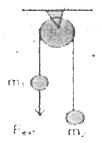A small body of mass m moving with velocity v0 on rough horizontal surface, finally stops due to friction. Find, the mean power developed by the friction force during the motion of the body, if the frictional coefficient μ=0.27,m=1 kg and v0=1.5ms−1.
The retardation due to friction is,
a=force of frictionmass=μmgm=−μg
Further, v0=at
Therefore, t=v0a=v0μg………..(i)
From work energy theorem,
work done by force of friction =change in kinetic energy
or W=12mv20..............(ii)
Mean power=Wt
From Eqs. (i) and (ii), we get
Pmean=12μmgv0
Substituting the values, we have
Pmean=12×0.27×1.0×9.8×1.5≈2W
Topper's Solved these Questions
- WORK, ENERGY AND POWERBOOK - DC PANDEYCHAPTER - WORK, ENERGY AND POWEREXERCISE - CHECK POINT 6.1
20 Videos
- WORK, ENERGY AND POWERBOOK - DC PANDEYCHAPTER - WORK, ENERGY AND POWEREXERCISE - CHECK POINT 6.2
20 Videos
- WORK, ENERGY & POWERBOOK - DC PANDEYCHAPTER - WORK, ENERGY & POWEREXERCISE - Level 2 Comprehension Based
2 Videos
- WORK, POWER AND ENERGYBOOK - DC PANDEYCHAPTER - WORK, POWER AND ENERGYEXERCISE - E Integer Type Questions
11 Videos
Similar Questions
A small body of mass m is located on a horizontal plane at the point O. The body acquires a horizontal velocity v0. Find the mean power developed by the friction force during the whole time of motion, if the frictional coefficient μ=0.27,m=1.0kg and v0=1.5ms−1.
View SolutionA small body of mass m is located on a horizontal plane at the point O. The body of mass m is located on a horizontal plane at the point O. The body acquires a horizontal velocity v0. Find,
(a) the mean power developed by the friction force during the whole time of motion, if the friction coefficient k=0.27, m=1.0kg, and v0=1.5m/s,
(b) the maximum instantaneous power developed by the friction force, if the friction coefficient varies as k=αx, where α is a constant, and x is the distance from the point O.
View Solution
Knowledge Check
An object of mass (m) is located on the horizontal plane at the origin O. The body acquires horizontal velocity V. The mean power developed by the frictional force during the whole time of motion is ( μ= frictional coefficient )
AμmgVB12μmgVCμmgVgD32μmgVA particle of mass m is given a velocity u on a rough horizontal surface of friction coefficient μ. The average power imparted by friction until it stops is
AzeroB12μmguCμmguD2μmgu
(i) Two bodies of masses m1(m2>m1) are connected by a light inextensible string which passes through a smooth fixed pulley. What is the instantaneous power delivered by an external agent to pull m1 with constant velocity →V?

(ii) A small body of mass m is located on a horizontal plane at any point O. The body acquires a horizontal velocity v0 . Find the mean power developed by the friction force during the motion, if the coefficient of friction μ=0.27,m=1.0 kg and v0=1.5m/s.
View SolutionA small body of mass m is located on a horizontal plane at the point O. The body of mass m is located on a horizontal plane at the point O. The body acquires a horizontal velocity v0. Find,
(a) the mean power developed by the friction force during the whole time of motion, if the friction coefficient k=0.27, m=1.0kg, and v0=1.5m/s,
(b) the maximum instantaneous power developed by the friction force, if the friction coefficient varies as k=αx, where α is a constant, and x is the distance from the point O.
View SolutionA small body of mass m is given velocity v0 at point O on rough horizontal surface. (a) Find the mean power developed by the friction force during the whole time of motion if the friction coefficient is constant and equal to μ0 (b) Find the maximum instantaneous power developed by the friction force, if the friction coefficient varies as μ=μ0x, where μ0 is a constant and x is the distance from the point O.
View SolutionA small body of mass m lies on a horizontal plane. The body is given a velocity v0, along the plane. (a) Find the mean power developed by the friction during the whole time of motion, if friction coefficient is μ=0.3,m=2.0kg and v0 = 3 m/s. (b) Find the maximum instantaneous power developed by the friction force, if the friction coefficient varies as μ=αx, where α is a constant and x is distance from the starting point
View SolutionA small body of mass m is located on a horizontal plane at the point O. The body of mass m is located on a horizontal plane at the point O. The body acquires a horizontal velocity v0. Find,
(a) the mean power developed by the friction force during the whole time of motion, if the friction coefficient k=0.27, m=1.0kg, and v0=1.5m/s,
(b) the maximum instantaneous power developed by the friction force, if the friction coefficient varies as k=αx, where α is a constant, and x is the distance from the point O.
View SolutionA body of mass 2kg is kept on a rough horizontal surface as shown in the figure. If coefficient of friction is 0.5, find the work done by frictional force in the interval t=0 to t=5sec

View Solution
